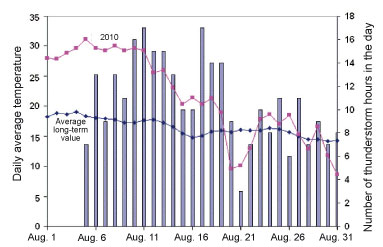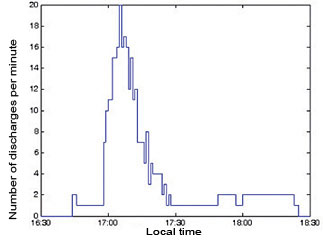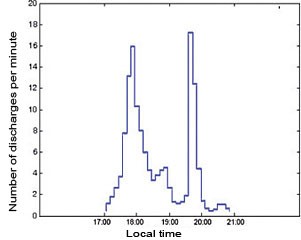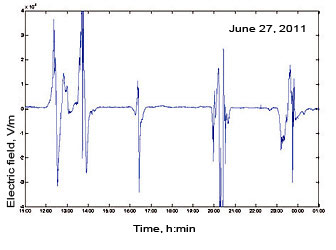Thunderstorm electricity and monitoring
of hazardous meteorological phenomena
The IAP RAS in close cooperation with the Roshydromet institutions studies the universal mechanisms and spatio-temporal characteristics of hazardous fast-growing phenomena in the atmosphere (destructive rain showers, thunderstorms, hail, etc.) to optimize the prevention technologies by rapid analysis of data from different systems of remote sensing of the atmosphere.
Recently, the problem of building systems for warning about hazardous weather phenomena, particularly thunderstorms, has attracted increased interest of geophysicists and meteorologists. Along with the conventional challenges from the thunderstorm electricity (disabling of electronic systems, impact on aviation, fire risk, etc.) and improvement of the methods of their control, more and more attention is drawn to the problems of electromagnetic pollution and its impact on ecosystems and human. Understanding of the role of the electrical processes in the dynamics and composition of the atmosphere changes significantly. There are experimental data obtained by balloon sounding of clouds, measurements onboard aircraft, observations using ground-based and satellite radar systems, experiments on the lightning discharge initiation, laboratory modeling of the cloud particle electrification, etc. Extensive data on the dynamics and charge of the precipitation from storm clouds have been obtained. Theoretical analysis of this new information requires new approaches based on modern methods of electrodynamics, nonlinear dynamics, and fractal and discrete mathematics.
In this area, the following main problems are addressed:
• studying the relationship between atmospheric electricity and the frequency and intensity of extreme climate phenomena (rain showers, squalls, storms, fires, etc.);
• creating models to describe the dynamics of storm clouds and the formation of intense precipitation zones in cloud systems based on analysis of the radar (active) sensing data;
• creating models to describe the lightning discharge in a thundercloud by analyzing its radio emission at different stages of the lightning discharge recorded by the passive HF and VHF radar systems;
• studying correlations among the atmospheric stability regime, the precipitation dynamics, and the evolution of the electric state of the atmosphere through the use of fractal analysis and self-organized criticality;
• developing methods for monitoring of the thunderstorm activity on a regional scale by reception of ELF and HF radiation of thunderstorms and measurement of the quasi-static electric field in the atmosphere.
In recent years, the IAP RAS researchers (E. A. Mareev, D. I. Iudin, Yu. V. Shlyugaev, V. V. Klimenko, etc.) in broad cooperation with Russian colleagues have obtained the following new results.
The main features of spectral characteristics of the thundercloud field perturbations have been examined through long-term (within the convective seasons of 2005—2012) ground-based measurements of the electric field at spaced locations. It is found that using the spectra of the thundercloud field perturbations on the ground, one can determine the average relaxation time of the field of the cloud environment
(a typical value about 10 s) and its effective conductivity.
Quasi-monochromatic components (with 10— 20 min periods) in the frequency spectra of the electric field fluctuations of powerful storm clouds, which drift in frequency during the initiation, activation, and decay of the cloud, have been detected. Frequency fluctuation spectra of the electric discharges also contain quasi-monochromatic components correlated with fluctuations in the electric field. The number of monochromatic components in the spectrum is related to the number of convective cells. This opens up an opportunity for remote diagnostics of the electroactive zones of deep storm clouds.
 |
The number of thunderstorm hours in the day (histogram)
and the temperature curve (line) in August 2010
|
Much attention is paid to the study of thunderstorms accompanied by rain showers, squalls, and hail. Along with the continuous measurements of the electric field at remote points, an original method was used to measure the number of thunderstorm hours in the day by recording the ELF radio emission (sferics) of the near and distant thunderstorms. The observations carried out in 2009—2011 show that the number of thunderstorm hours in the day correlates with the mean temperature of the air and is a quantitative indicator of the intensity of the atmospheric convective processes both under mean climatologic conditions and in abnormally hot and dry weather.
Recently, special attention is paid to studying climate trends of thunderstorm activity. Observations of the seasons of 2009—2011 support the hypothesis that the average temperature rise of the air leads to increased intensity of the hydrological cycle, but the overall increase in precipitation over land is manifested primarily in the increasing number of intense rainfalls, thunderstorms, and squalls.
 |
 |
The electric activity characteristics (according to the fluxmeter in Nizhny Novgorod) of intense thunderstorms
of August 19, 2010 (left) and August 22, 2009 (right)
|
A model describing the dynamics of the electric structure and the formation of intense charge layers in cloud systems has been developed. The model is based on a system of quasi-hydrodynamic equations for the major fractions of the system with allowance for electrification during the melting of cloud particles. Obtained solutions describe the structure and dynamics of the electric charge areas in the stratified region of nimbostratus and mesoscale convective systems.
A basis for the model describing the dynamics of thunderstorm clouds and the formation of intense precipitation zones with the use of atmospheric radar sensing and passive ELF and HF radar data has been developed. It is found that variations in the fractal dimensions of a radar image have a high correlation with variations in the radar echo intensity and thunderstorm activity, and this can be used for rapid monitoring of intense precipitation zones and electroactive zones in cloud systems.
 |
Atmospheric electric field perturbations recorded on May 27, 2011 by an electrostatic fluxmeter installed on the roof of the IAP RAS (momentary average)
|
The physical mechanisms responsible for the generation of nitrogen oxides in the atmosphere during thunderstorm discharges in the troposphere and middle atmosphere have been analyzed and the impact of this process on the state of the climate system has been estimated. Using a chemical-climate model of high resolution and with allowance for the feedback between changes in the atmospheric composition and structure, climatologic significance of the thunderstorm production of nitrogen oxides has been proved. It is shown that the ozone content changes several times with the variation in the rate of thunderstorm formation of nitrogen oxides within the natural uncertainty. An increase in nitrogen oxides of the thunderstorm origin leads to a significant increase in the hydroxyl radical in the troposphere.
A three-dimensional model of the fractal dynamics of micro-discharges in a thunderstorm cloud, which form a drainage system for collecting an electric macro-
charge and determine the formation of the lightning leader channel, has been devised. The model permits one to quantitatively explain the dynamics of the electric fields and currents, as well as characteristics of the radio emission at the preliminary stage of a thunderstorm discharge.
The methods developed in this area are needed to address many of the practical problems, including the introduction of new environmental monitoring systems, improved lightning protection, the creation of new energy-efficient technologies, solution of the electromagnetic compatibility problems, improved methods of long-term and short-term forecast, etc.
|
|
Typical configuration of the conductive
prefractal graph. Peripheral points
are marked in red
|
Devices for measuring the electric field
and radio emission
of the lightning discharges
|





